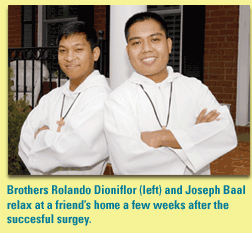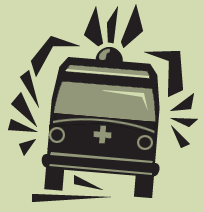|
 |
|
|













|

|
|
|
 |
Highlights:
 |
 |
 |
 |
Brother,
can you spare a kidney?
Help for Atlanta hearts
Humanitarian effort
Tort reform a reality
Milestones
 |
 |
 |
 |
 |
Brother,
can you spare a kidney?
A
chance encounter,  powerful
Emory connections, and some incredible generosity all combined recently
to give the gift of life to a young missionary, enabling him to
continue his calling to serve the poorest of the poor. powerful
Emory connections, and some incredible generosity all combined recently
to give the gift of life to a young missionary, enabling him to
continue his calling to serve the poorest of the poor.
Last December, Joseph Baal, 26, a
Brother with the Missionaries of the Poor, a Catholic monastic order
based in Kingston, Jamaica, donated a kidney to fellow Brother Rolando
Dioniflor, 27, in an operation performed at Emory University Hospital.
The transplant might never have happened if not for the efforts
of a group of nurses and doctors from across Atlanta and a friendship
between Marla Salmon, dean of the Nell Hodgson Woodruff School of
Nursing, and Vicki Moore, chief of nursing at Atlanta’s St.
Joseph’s Hospital.
The Missionaries’ founder, Father
Richard Ho Lung, underwent open heart surgery at St. Joseph’s
in November 2003 and confided in Moore about Rolando’s need
for a transplant.
All of the Brothers were willing to
be tested to see if they could donate a kidney, he said. But the
missionaries could hardly afford the expensive preparations and
surgeries that would follow. So Moore contacted Salmon, who worked
to get Emory Hospital’s transplant service involved.
“Marla and I have collaborated
over the years on nursing service and education programs, so I went
to her for assistance in making this need known to the hospital
administration and renal transplant team,” she says.
Moore, Salmon, and Maureen Kelley,
an Emory associate professor of nursing, worked together to get
the needed health care services donated. St. Joseph’s provided
some of the preoperative care for Brother Rolando. WellStar-Kennestone
Hospital sponsored the donor testing, and Emory Hospital and surgeon
Christian Larsen, provided the transplant operation and follow-up
care.
Fortunately, Brother Joseph proved
to be an excellent donor. He and Rolando traveled to Atlanta, staying
with a local host family for five months during the surgeries and
post-operative care.
Kelley, chair of the School of Nursing’s
Department of Family and Community Nursing, frequently leads groups
of students on international trips to provide needed medical assistance
in underserved areas. On a previous trip to Kingston, she visited
the Missionaries, observing the shelters where they provide care
for vulnerable homeless people, many of whom are terminally ill.
The transplant, she points out, will benefit many people beyond
Brother Rolando.
“When I visited the Missionaries
of the Poor, I was awestruck at the compassion and care that the
Brothers provide for the destitute and sick in Jamaica,” she
says. “People like Brother Rolando make a profound difference
in these people’s lives, and I’m thrilled that we at
Emory were able to make a difference in his.”
Following a quick recovery, both Brothers
returned to Jamaica last February to resume their work and to pursue
studies for the priesthood.
“When I think about what Brother
Joseph did for me, it really inspires me to be more generous in
my life, since he has shown such love and generosity,” said
Rolando shortly before leaving Atlanta for home. “I just want
to live the best life that I can, to take this gift of a new life
and use it.”
|
 |
 |
| |
|
|
|
| |
 |
Help
for Atlanta hearts
When
discussing heart attacks, cardiologists often refer to
their own created proverb, “Time is muscle.”
Prompt access to
coronary angioplasty offers the best chance of preventing permanent
damage, but not all hospitals have the capability to provide immediate
angioplasty, and too few patients receive treatment in time.
“About 1 million people a year
will have a heart attack,” says cardiologist Doug Morris,
director of the Emory Heart Center. “About half of them will
die, almost 400,000 before they even get to the hospital.”
A new joint effort by Emory Healthcare
and Grady Health System may help change that. Operating with the
motto: “911 to cath lab in under 90 minutes,” the Heart
Attack Rescue Team (HART) program  allows
early diagnosis of heart attacks in the field and faster treatment
once patients reach the hospital. allows
early diagnosis of heart attacks in the field and faster treatment
once patients reach the hospital.
Emory has provided portable electrocardiography
machines to all Grady ambulances, allowing EMS personnel to transmit
ECGs taken in the field to either Emory University Hospital or Emory
Crawford Long. Both facilities can provide angioplasty 24 hours
a day, seven days a week. An emergency medicine physician at the
hospital determines whether the patient is having a heart attack
and whether angioplasty or therapy with clot-dissolving drugs is
appropriate.
If angioplasty is an option, the cardiac
catheterization team is notified and prepares to take the patient.
The patient is then asked whether he or she prefers to be transported
there for angioplasty or to another hospital. If the patient chooses
another hospital, Emory calls to inform doctors there that the patient
has an abnormal ECG and will require rapid treatment.
“HART is a completely voluntary
program,” emphasizes Arthur Kellermann, chair of the Department
of Emergency Medicine at Emory.” The patient can choose to
go to Emory or Crawford Long or another hospital. If they choose
us, we are preparing the cath table while they still are on the
way to the hospital. If the patient opts out, we still call ahead
and advise the other facility of the patient’s condition.
Either way, this program will reduce the lost time in getting that
person lifesaving treatment.”
HART is part of Emory’s ongoing
push to improve and standardize cardiac care in the Atlanta region,
says Morris. Earlier efforts to encourage the use of field ECGs
across the metro area have met with some resistance. But if data
from Grady and Emory’s effort shows improved outcomes, more
hospitals and other EMS systems may be willing to adopt this strategy.
The hope is that the HART program
will serve as a public health model for improving survival rates,
says Kellermann.
“We are trying to do for heart
attacks what we have done for trauma,” he explains. “We
want to provide rapid, organized, high-quality response to a life-threatening
event.”
|
 |
 |
| |
|
|
|
|
 |
Humanitarian
effort
 Brandon
Kohrt, in his fifth year of MD/PhD training in medicine
and anthropology, has been recognized by the group Physicians for
Human Rights for his work with immigrants who have survived torture
in their home countries. He is the recipient of the 2005 Navin Narayan
Award recognizing his ongoing commitment to health and human rights
activism. Brandon
Kohrt, in his fifth year of MD/PhD training in medicine
and anthropology, has been recognized by the group Physicians for
Human Rights for his work with immigrants who have survived torture
in their home countries. He is the recipient of the 2005 Navin Narayan
Award recognizing his ongoing commitment to health and human rights
activism.
In 2003, Kohrt helped found the Atlanta
Asylum Network, which recruits medical professionals to document
evidence of abuse so that survivors can apply for refugee status.
“For many people who have survived
physical or mental torture, their primary concern has been getting
to safety,” Kohrt explains. “When they get here, they
may still be in shock. Or, wanting to put the past behind them,
they may be reluctant to talk about what has happened to them.”
“If we are able to document
psychological signs—such as post-traumatic stress disorder—or
physical injuries consistent with abuse, then our documentation
as medical professionals can be used as evidence in immigration
proceedings,” he says.
Kohrt became interested in this issue
after traveling to Nepal on a Fulbright scholarship and meeting
people who had been kidnapped and tortured there. After college,
he also worked on a project providing mental health services to
immigrants in Los Angeles.
His experiences convinced him of the
need to document the effects of torture on survivors, both to prevent
their deportation and also to help them obtain counseling and assistance.
The asylum network plans to expand
its services and is always in need of new volunteers, says Kohrt.
More information can be found on the Physicians
for Human Rights’ website or Emory’s
Institute for Human Rights.
|
 |
 |
| |
|
|
|
|
| |
|
|
|
|
|
|
 |
Tort reform a reality
By
Linda Womack
The
Woodruff Health Sciences Center (WHSC) had a productive session
at the state Capitol this year, successfully achieving much of its
legislative agenda.
On
February 16, Governor Sonny Perdue signed into law Senate Bill 3,
better known as civil justice or tort reform legislation, which
establishes new limits on medical malpractice awards in the state.
Passage of this legislation has been our No. 1 goal for the past
three sessions of the Georgia General Assembly. The new law’s
provisions include the following:
 Elimination
of the joint and several liability rule in favor of Elimination
of the joint and several liability rule in favor of
proportional liability. Under proportional liability, a
defendant is responsible only for his or her share of the damages.
 Strengthening
of expert witness qualifications by requiring experts to have either
practiced or taught in the area of practice or specialty at issue
for three of the five years preceding the alleged negligence. Strengthening
of expert witness qualifications by requiring experts to have either
practiced or taught in the area of practice or specialty at issue
for three of the five years preceding the alleged negligence.
 A total
limit on awards for non-economic damages of $1.05 million, with
a $350,000 cap on licensed physicians and other health care providers
and a $350,000 per facility cap for up to two facilities. A total
limit on awards for non-economic damages of $1.05 million, with
a $350,000 cap on licensed physicians and other health care providers
and a $350,000 per facility cap for up to two facilities.
 A stipulation
that offers of settlement, statements of apology and benevolence,
or statements indicating regret, mistake, error, or sympathy are
prohibited from being admitted into evidence as an admission of
liability. A stipulation
that offers of settlement, statements of apology and benevolence,
or statements indicating regret, mistake, error, or sympathy are
prohibited from being admitted into evidence as an admission of
liability.
 No liability
for claims arising from the provision of emergency care unless it
is proven by clear and convincing evidence that the provider’s
action showed gross negligence. No liability
for claims arising from the provision of emergency care unless it
is proven by clear and convincing evidence that the provider’s
action showed gross negligence.
 Removal
of hospital liability for community physicians who provide services
under independent contractor arrangements. Removal
of hospital liability for community physicians who provide services
under independent contractor arrangements.
The WHSC also led a successful effort
to reform the process used by the Composite State Board of Medical
Examiners to grant medical licensure to physicians in training.
While the positions of intern, resident, and fellow are often used
interchangeably when designating a physician in graduate medical
education, Georgia law previously recognized only board-approved
internship and residency positions as eligible for medical licensure
in the state.
Provisions of House Bill (HB) 608,
signed into law on May 2, add the categories of fellowship or other
postgraduate medical training positions that are approved by the
Accreditation Council for Graduate Medical Education, the American
Osteopathic Association, or the state medical board eligible for
a license to practice medicine in Georgia. The board is also given
the discretion to consider an applicant’s certification by a member board of the American Board of Medical
Specialties as evidence that the postgraduate medical training has
satisfied requirements for licensure.
certification by a member board of the American Board of Medical
Specialties as evidence that the postgraduate medical training has
satisfied requirements for licensure.
A number of study commissions and
committees were created during the 2005 session. Of particular importance
to the WHSC is the new law (formerly HB 390) that created a State
Commission on the Efficacy of the Certificate of Need (CON) Program.
In 1979, Georgia’s legislature
passed the CON law to combat over investment in health services
in wealthy areas and to ensure access to health care for both the
state’s rural and urban populations. Georgia’s law followed
passage of a 1974 federal law that established a network of state
health planning and development agencies that monitor the equitable
distribution of health care resources.
This state commission is in the process
of conducting a comprehensive review of the CON program, examining
its effectiveness, studying the costs associated with the program,
and looking at the potential impact of continuing or discontinuing
it. The commission has until June 30, 2007, to issue a report to
the governor and General Assembly announcing its findings.
For additional information on any
of these legislative issues, please contact Linda Womack at 404-727-5306
or linda.womack@emory.edu.
Linda Womack is the director of state government affairs for the
Emory University Office of Governmental and Community Affairs.
Linda
Womack is the director of state government affairs for the Emory
University Office of Governmental and Community Affairs.
|
 |
 |
| |
|
|
|
| |
| |
|
|
|
|
|
|
 |
Milestones
New rankings
from the National Institutes of Health show that Emory University
School of Medicine continues to be one of the fastest-growing medical
schools in the country in terms of federal research grant support.
Emory researchers received more than $178 million in NIH grant support
last year, with the school ranking 19th among all U.S. medical schools.
Emory has climbed four places in the rankings since 2003 and 12
places since 1996, the second-greatest increase among schools of
medicine in the country during that time period.
Meanwhile, researchers in the Rollins
School of Public Health ranked 10th among all U.S. schools of public
health, up from 12th the previous year. The $20.8 million in funding
that the school received last year was a 37% increase over 2003
NIH funding of $15.2 million.
Researchers in the Nell Hodgson Woodruff School of Nursing ranked
19th among all U.S. schools of nursing in NIH funding, maintaining
a top 20 ranking for two years in a row. Including the $2.32 million
in NIH money, the school received a total of $3.2 million in external
funding for research and training last year.
|
 |
 |
| |
|
|
 |

UNDER CONSTRUCTION
The School of Medicine
has already raised $31 million of the $55 million needed to
complete construction of a new home adjacent to the Woodruff
Health Sciences Center Administration Building (WHSCAB).
The school’s 150th Anniversary
Gala, held on May 13, netted more than $300,000 for the project.
In addition, the school has recruited nine members of the
“150 Society,” a group of donors who have given
$150,000 or more to the new building.
The planned three-building complex
will include a new 116,000-square-foot teaching and administration
building connecting the existing Anatomy and Physiology buildings.
Those buildings are now empty and awaiting renovation.
connecting the existing Anatomy and Physiology buildings.
Those buildings are now empty and awaiting renovation.
When complete, the complex will
feature wireless computer networking throughout the facility,
extensive space dedicated to simulation, a state-of-the-art
dissection lab, clinical exam rooms equipped with TV cameras
for standardized patient testing, as well as new classrooms,
meeting rooms, lecture halls, and space for the school’s
administrative offices. The new building is slated for occupancy
in June 2007.

|
 |
 |
|
 |
| |
|
|
|
|
 |
National
Heart, Lung and Blood Institute
(NHLBI) at the NIH has awarded researchers from Georgia Institute
of Technology and Emory University $11.5 million to establish a
new research program focused on creating advanced nanotechnologies
to analyze vascular plaque formation at the molecular level and
detect plaque at its early stages. Plaques containing cholesterol
and lipids build up during the life of blood vessels. When these
plaques become unstable and rupture, they can block vessels, leading
to heart attack and stroke.
The new multi-disciplinary program,
part of NHLBI’s Program of Excellence in Nanotechnology, is
headed by Gang Bao, a professor in the Wallace H. Coulter Department
of Biomedical Engineering at Georgia Tech and Emory. The program
includes 12 faculty investigators from both institutions and is
based at Emory. |
 |
| |
|
|
|
|
 |
| |
|
|
 |
THE
NATIONAL INSTITUTE ON AGING
(NIA)
has awarded a highly coveted Alzheimer’s Disease Research
Center designation to Emory University, along with $7.4 million
in research funding over the next five years. The Emory Alzheimer’s
Disease Research  Center
is the only NIA-funded center in Georgia and one of only
32 in the United States to attain this top status. Comparable
to the National Cancer Institute’s Comprehensive Cancer
Center designation for excellence in cancer research and community
outreach programs, the Alzheimer’s Disease Research
Center designation signifies the highest status an institution
can receive in Alzheimer’s research and care. Center
is the only NIA-funded center in Georgia and one of only
32 in the United States to attain this top status. Comparable
to the National Cancer Institute’s Comprehensive Cancer
Center designation for excellence in cancer research and community
outreach programs, the Alzheimer’s Disease Research
Center designation signifies the highest status an institution
can receive in Alzheimer’s research and care.
|
 |
 |
|
 |
 |
| |
|
|
|
| |
|
|
|





 powerful
Emory connections, and some incredible generosity all combined recently
to give the gift of life to a young missionary, enabling him to
continue his calling to serve the poorest of the poor.
powerful
Emory connections, and some incredible generosity all combined recently
to give the gift of life to a young missionary, enabling him to
continue his calling to serve the poorest of the poor.

 allows
early diagnosis of heart attacks in the field and faster treatment
once patients reach the hospital.
allows
early diagnosis of heart attacks in the field and faster treatment
once patients reach the hospital. 

 Brandon
Kohrt, in his fifth year of MD/PhD training in medicine
and anthropology, has been recognized by the group Physicians for
Human Rights for his work with immigrants who have survived torture
in their home countries. He is the recipient of the 2005 Navin Narayan
Award recognizing his ongoing commitment to health and human rights
activism.
Brandon
Kohrt, in his fifth year of MD/PhD training in medicine
and anthropology, has been recognized by the group Physicians for
Human Rights for his work with immigrants who have survived torture
in their home countries. He is the recipient of the 2005 Navin Narayan
Award recognizing his ongoing commitment to health and human rights
activism.

 certification by a member board of the American Board of Medical
Specialties as evidence that the postgraduate medical training has
satisfied requirements for licensure.
certification by a member board of the American Board of Medical
Specialties as evidence that the postgraduate medical training has
satisfied requirements for licensure.
 connecting the existing Anatomy and Physiology buildings.
Those buildings are now empty and awaiting renovation.
connecting the existing Anatomy and Physiology buildings.
Those buildings are now empty and awaiting renovation. Center
is the only NIA-funded center in Georgia and one of only
32 in the United States to attain this top status. Comparable
to the National Cancer Institute’s Comprehensive Cancer
Center designation for excellence in cancer research and community
outreach programs, the Alzheimer’s Disease Research
Center designation signifies the highest status an institution
can receive in Alzheimer’s research and care.
Center
is the only NIA-funded center in Georgia and one of only
32 in the United States to attain this top status. Comparable
to the National Cancer Institute’s Comprehensive Cancer
Center designation for excellence in cancer research and community
outreach programs, the Alzheimer’s Disease Research
Center designation signifies the highest status an institution
can receive in Alzheimer’s research and care.